The global storm water cleaning services market is valued at USD 3.7 billion in 2025 and is slated to reach USD 5.2 billion by 2035, recording an absolute increase of USD 1.3 billion over the forecast period. This translates into a total growth of 35.1%, with the market forecast to expand at a compound annual growth rate (CAGR) of 3.5% between 2025 and 2035. The overall market size is expected to grow by nearly 1.4X during the same period, supported by increasing climate variability, growing urbanization pressure, and rising emphasis on infrastructure maintenance across diverse storm water management applications.
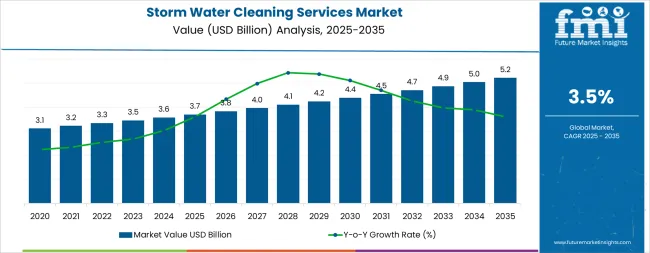
Between 2025 and 2030, the storm water cleaning services market is projected to expand from USD 3.7 billion to USD 4.2 billion, resulting in a value increase of USD 0.5 billion, which represents 38.5% of the total forecast growth for the decade. This phase of development will be shaped by increasing extreme weather events, rising regulatory compliance requirements, and growing adoption of advanced cleaning technologies in municipal and industrial applications. Service providers are expanding their hydro-excavation and vacuum loading capabilities to address the growing demand for efficient drainage maintenance solutions and enhanced environmental compliance.
| Metric | Value |
|---|---|
| Estimated Value in (2025E) | USD 3.7 billion |
| Forecast Value in (2035F) | USD 5.2 billion |
| Forecast CAGR (2025 to 2035) | 3.5% |
From 2030 to 2035, the market is forecast to grow from USD 4.2 billion to USD 5.2 billion, adding another USD 0.8 billion, which constitutes 61.5% of the overall ten-year expansion. This period is expected to be characterized by the expansion of AI-powered inspection technologies, the integration of robotic cleaning systems, and the development of predictive maintenance solutions for storm water infrastructure. The growing adoption of eco-efficient urban drainage systems and smart city initiatives will drive demand for storm water cleaning services with enhanced efficiency and reduced environmental impact.
Between 2020 and 2025, the storm water cleaning services market experienced steady growth, driven by increasing municipal demand for drainage maintenance solutions and growing recognition of storm water cleaning as essential infrastructure for flood prevention and water quality protection. The market developed as municipalities and industries recognized the potential for professional cleaning services to enhance system reliability while reducing maintenance costs and regulatory compliance risks. Technological advancement in cleaning equipment and inspection methods began emphasizing the critical importance of maintaining drainage efficiency and environmental protection in urban infrastructure management.
Market expansion is being supported by the increasing global frequency of extreme weather events and the corresponding need for drainage infrastructure that can maintain operational efficiency and prevent flooding while supporting environmental compliance across various municipal and industrial applications. Modern municipalities and industries are increasingly focused on implementing maintenance solutions that can reduce system downtime, minimize environmental impact, and provide consistent performance in storm water management. Storm water cleaning services' proven ability to deliver enhanced drainage efficiency, reduced blockage risks, and versatile infrastructure maintenance capabilities make them essential services for contemporary urban management and environmental protection solutions.
The growing emphasis on regulatory compliance and infrastructure resilience is driving demand for storm water cleaning services that can support pollution prevention, reduce maintenance costs, and enable efficient drainage system operation throughout varying weather conditions. Municipal authorities' preference for maintenance services that combine operational efficiency with environmental protection and cost-effectiveness is creating opportunities for innovative storm water cleaning implementations. The rising influence of climate adaptation strategies and urban sustainability initiatives is also contributing to increased adoption of storm water cleaning services that can provide reliable drainage maintenance without compromising water quality or system performance.
The storm water cleaning services market is poised for steady growth and transformation. As municipalities and industries across both developed and emerging markets seek drainage maintenance that is efficient, compliant, reliable, and eco-efficient, storm water cleaning services are gaining prominence not just as reactive maintenance solutions but as strategic infrastructure management for flood prevention, water quality protection, regulatory compliance, and system optimization.
Rising urbanization and climate variability in South Asia & Pacific, East Asia, Latin America amplify demand, while service providers are picking up on innovations in cleaning technologies and equipment improvements.
Pathways like hydro-excavation services, industrial cleaning specialization, and technology integration promise strong margin uplift, especially in developed markets. Geographic expansion and service diversification will capture volume, particularly where aging infrastructure requires maintenance or regulatory requirements are strengthening. Environmental pressures around water quality, flood prevention, infrastructure resilience, and pollution control give structural support.
The market is segmented by service type, application, and region. By service type, the market is divided into root cutting, hydro-excavation, vacuum loading, water jetting, and others. By application, it is segmented into residential storm water cleaning services, commercial storm water cleaning services, and industrial storm water cleaning services. Regionally, the market is divided into North America, Latin America, Western Europe, Eastern Europe, East Asia, South Asia & Pacific, and Middle East & Africa.

The hydro-excavation segment is projected to record the highest CAGR of 25.0% during 2025-2035, establishing its position as the fastest-growing service category. Municipal authorities and industrial operators increasingly utilize hydro-excavation services for their superior safety profile, precision capabilities, and non-destructive approach to underground infrastructure exposure and drainage system maintenance. Hydro-excavation technology's advanced water and vacuum capabilities and consistent operational output directly address the infrastructure requirements for safe excavation and efficient maintenance in complex urban and industrial environments.
This service segment represents the future of infrastructure maintenance operations, as it provides the technology with the greatest safety advantages and established performance benefits across multiple applications and maintenance scenarios. Service provider investments in enhanced hydro-excavation equipment and operator training continue to strengthen adoption among municipalities and industries. With authorities prioritizing worker safety and infrastructure protection, hydro-excavation services align with both operational efficiency objectives and regulatory compliance requirements, making them the preferred component of comprehensive storm water maintenance strategies.
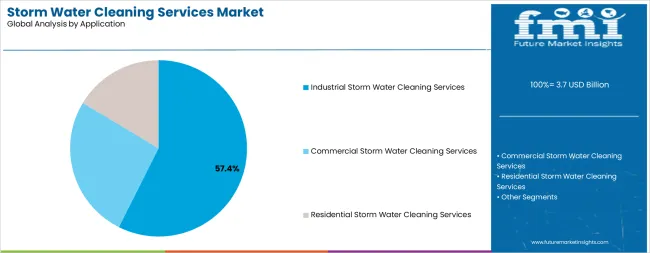
Industrial storm water cleaning services is projected to represent 57.4% of storm water cleaning demand by 2035, underscoring its critical role as the primary application of professional cleaning services for manufacturing facilities and industrial complexes. Industrial operators prefer specialized storm water cleaning for their regulatory compliance requirements, pollution prevention capabilities, and ability to handle contaminated runoff while supporting environmental protection and operational continuity. Positioned as essential services for modern industrial operations, storm water cleaning offers both regulatory advantages and operational benefits.
The segment is supported by continuous innovation in industrial cleaning techniques and the growing availability of specialized equipment that enables effective contamination control with enhanced safety protocols. Additionally, industrial facilities are investing in preventive maintenance programs to support large-scale regulatory compliance and environmental protection. As environmental regulations become more stringent and industrial accountability requirements increase, industrial storm water cleaning services will continue to dominate the application market while supporting advanced compliance strategies and environmental stewardship initiatives.
The storm water cleaning services market is advancing steadily due to increasing municipal demand for drainage maintenance and growing adoption of regulatory compliance infrastructure that provides flood prevention and water quality protection across diverse urban and industrial applications. However, the market faces challenges, including fragmented service provider landscapes, infrastructure disparity across regions, and the need for specialized equipment investments. Innovation in hydro-excavation technologies and automated inspection solutions continues to influence service development and market expansion patterns.
The growing frequency of heavy rainfall events and storm surges is enabling municipalities and industries to deploy storm water cleaning services that provide enhanced drainage capacity, superior flood prevention, and reliable infrastructure maintenance capabilities. Advanced cleaning services provide improved system performance while allowing more effective debris removal and consistent drainage operation across various weather conditions and emergency scenarios. Service providers are increasingly recognizing the competitive advantages of emergency response capabilities for storm water maintenance and flood prevention positioning.
Modern regulatory frameworks are incorporating pollution control standards and water quality monitoring systems to enhance environmental protection, optimize drainage performance, and ensure consistent regulatory compliance delivery to environmental authorities. These regulations improve operational accountability while enabling new service applications, including contamination control and specialized industrial cleaning solutions. Advanced compliance integration also allows service providers to support premium positioning and long-term contracts beyond traditional maintenance service supply.
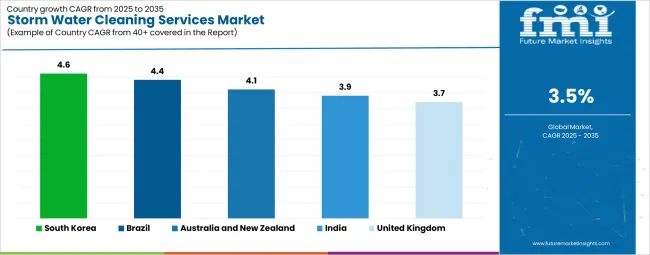
| Country | CAGR (2025-2035) |
|---|---|
| South Korea | 4.6% |
| Brazil | 4.4% |
| Australia and New Zealand | 4.1% |
| India | 3.9% |
| United Kingdom | 3.7% |
The storm water cleaning services market is experiencing steady growth globally, with South Korea leading at a 4.6% CAGR through 2035, driven by the expanding urban infrastructure development, growing climate adaptation initiatives, and significant investment in drainage system modernization. Brazil follows at 4.4%, supported by increasing urbanization pressure, infrastructure improvement programs, and growing environmental compliance requirements. Australia and New Zealand show growth at 4.1%, emphasizing flood management and environmental protection. India records 3.9%, focusing on urban development and infrastructure modernization. The United Kingdom demonstrates 3.7% growth, supported by aging infrastructure maintenance and regulatory compliance requirements.
The report covers an in-depth analysis of 40+ countries top-performing countries are highlighted below.
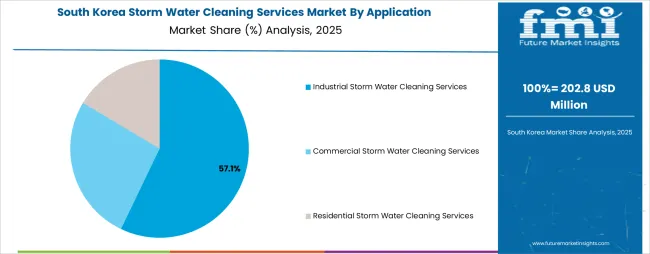
Revenue from storm water cleaning services in South Korea is projected to exhibit exceptional growth with a CAGR of 4.6% through 2035, driven by expanding urban infrastructure development and rapidly growing climate adaptation initiatives supported by government smart city programs. The country's comprehensive urban planning strategy and increasing investment in drainage modernization are creating substantial demand for advanced storm water cleaning solutions. Major municipalities and infrastructure operators are establishing comprehensive cleaning service capabilities to serve both domestic infrastructure maintenance and climate resilience requirements.
Revenue from storm water cleaning services in Brazil is expanding at a CAGR of 4.4%, supported by the country's rapid urbanization trends, infrastructure development programs, and increasing environmental compliance requirements. The country's growing urban centers and expanding industrial sectors are driving demand for sophisticated storm water cleaning capabilities. Municipal authorities and industrial operators are establishing extensive service partnerships to address the growing demand for efficient drainage maintenance and environmental protection.
Revenue from storm water cleaning services in Australia and New Zealand is expanding at a CAGR of 4.1%, supported by the countries' emphasis on flood management, strong environmental protection standards, and investment in infrastructure resilience initiatives. The region's mature regulatory framework and emphasis on eco-efficient urban drainage are driving demand for specialized storm water cleaning technologies across major metropolitan areas. Service providers and municipalities are establishing comprehensive capabilities to serve both domestic infrastructure needs and environmental protection requirements.
Revenue from storm water cleaning services in India is growing at a CAGR of 3.9%, driven by expanding urban development, increasing infrastructure investment, and growing awareness of drainage system maintenance requirements. The country's rapid urbanization and smart city initiatives are supporting demand for professional storm water cleaning technologies across major metropolitan areas. Municipal corporations and industrial facilities are establishing service partnerships to serve both domestic infrastructure development and environmental compliance markets.
Revenue from storm water cleaning services in the United Kingdom is expanding at a CAGR of 3.7%, supported by the country's focus on aging infrastructure maintenance, comprehensive regulatory frameworks, and strategic investment in drainage system upgrades. The UK's established urban infrastructure and emphasis on environmental protection are driving demand for specialized storm water cleaning technologies focusing on system optimization and regulatory compliance. Local authorities are investing in comprehensive maintenance programs to serve both domestic infrastructure needs and environmental protection requirements.
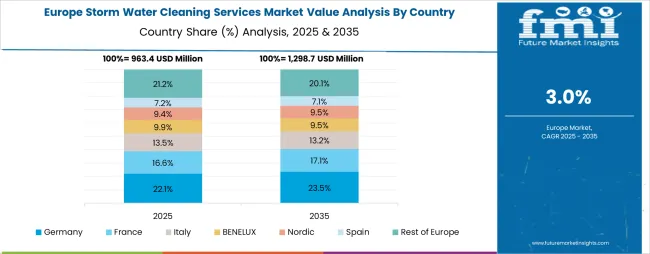
The storm water cleaning services market in Europe is projected to grow from USD 1.2 billion in 2025 to USD 1.6 billion by 2035, registering a CAGR of 3.3% over the forecast period. Germany is expected to maintain its leadership position with a 26.0% market share in 2025, maintaining 26.0% by 2035, supported by its strong environmental regulations, advanced infrastructure maintenance systems, and comprehensive municipal drainage networks serving major industrial regions.
United Kingdom follows with a 22.0% share in 2025, projected to reach 22.5% by 2035, driven by aging infrastructure maintenance requirements, stringent environmental compliance standards, and established drainage system modernization programs, combined with strong municipal investment in flood prevention. France holds an 18.0% share in 2025, expected to maintain 18.0% by 2035, supported by urban infrastructure development and environmental protection initiatives but facing challenges from municipal budget constraints and service provider consolidation. Netherlands commands a 12.0% share in 2025, projected to reach 12.2% by 2035, while Italy accounts for 10.0% in 2025, expected to reach 10.1% by 2035. Spain maintains a 8.0% share in 2025, growing to 8.2% by 2035. The Rest of Europe region, including Nordic countries, Eastern European markets, Belgium, Switzerland, and other European countries, is anticipated to gain momentum, expanding its collective share from 4.0% to 3.0% by 2035, attributed to increasing infrastructure investment across Nordic countries and growing drainage system modernization across various European markets implementing climate adaptation programs.
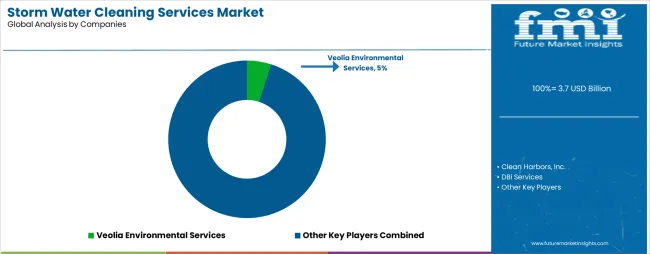
The storm water cleaning services market is characterized by competition among established environmental service companies, specialized drainage maintenance providers, and regional cleaning service operators. Companies are investing in advanced cleaning equipment research, service capability optimization, regulatory compliance enhancement, and comprehensive service portfolios to deliver efficient, reliable, and cost-effective storm water cleaning solutions. Innovation in hydro-excavation technologies, vacuum loading systems, and automated inspection capabilities is central to strengthening market position and competitive advantage.
Veolia Environmental Services leads the market with a strong market share, offering comprehensive environmental services with a focus on municipal applications and industrial compliance. Clean Harbors Inc. provides specialized hazardous material handling capabilities with an emphasis on industrial cleaning and regulatory compliance. DBi Services delivers innovative drainage maintenance solutions with a focus on technology integration and operational efficiency. Hydro International specializes in storm water treatment systems and cleaning equipment for municipal markets. Roto-Rooter Services Company focuses on residential and commercial drainage services with nationwide coverage. Storm Water Maintenance LLC offers specialized storm water infrastructure services with emphasis on municipal contracts and compliance applications.
| Items | Values |
|---|---|
| Quantitative Units (2025) | USD 3.7 billion |
| Service Type | Root Cutting, Hydro-excavation, Vacuum Loading, Water Jetting, Others |
| Application | Residential Storm Water Cleaning Services, Commercial Storm Water Cleaning Services, Industrial Storm Water Cleaning Services |
| Regions Covered | North America, Latin America, Western Europe, Eastern Europe, East Asia, South Asia & Pacific, Middle East & Africa |
| Countries Covered | United States, Japan, Germany, India, United Kingdom, France, Italy, Brazil, Canada, South Korea, Australia, Spain, Netherlands, Saudi Arabia and 40+ countries |
| Key Companies Profiled | Veolia Environmental Services, Clean Harbors Inc., DBi Services, Hydro International, Roto-Rooter Services Company, and Storm Water Maintenance LLC |
| Additional Attributes | Service sales by type and application category, regional demand trends, competitive landscape, technological advancements in cleaning systems, equipment innovation, regulatory compliance development, and infrastructure maintenance optimization |
The global storm water cleaning services market is estimated to be valued at USD 3.7 billion in 2025.
The market size for the storm water cleaning services market is projected to reach USD 5.2 billion by 2035.
The storm water cleaning services market is expected to grow at a 3.5% CAGR between 2025 and 2035.
The key product types in storm water cleaning services market are hydro-excavation, root cutting, vacuum loading, water jetting and others.
In terms of application, industrial storm water cleaning services segment to command 57.4% share in the storm water cleaning services market in 2025.






Full Research Suite comprises of:
Market outlook & trends analysis
Interviews & case studies
Strategic recommendations
Vendor profiles & capabilities analysis
5-year forecasts
8 regions and 60+ country-level data splits
Market segment data splits
12 months of continuous data updates
DELIVERED AS:
PDF EXCEL ONLINE
Storm Surge Barriers Market
Cytokine Storm Therapy Market
Waterless Bathing Solution Market Size and Share Forecast Outlook 2025 to 2035
Water Treatment System Market Size and Share Forecast Outlook 2025 to 2035
Waterborne UV Curable Resin Market Size and Share Forecast Outlook 2025 to 2035
Water Treatment Chemical Market Size and Share Forecast Outlook 2025 to 2035
Water Adventure Tourism Market Forecast and Outlook 2025 to 2035
Water Packaging Market Forecast and Outlook 2025 to 2035
Water Soluble Bag Market Size and Share Forecast Outlook 2025 to 2035
Water Leak Sensors Market Size and Share Forecast Outlook 2025 to 2035
Water-soluble Packaging Market Size and Share Forecast Outlook 2025 to 2035
Water Leak Detection System for Server Rooms and Data Centers Market Size and Share Forecast Outlook 2025 to 2035
Water and Wastewater Treatment Equipment Market Size and Share Forecast Outlook 2025 to 2035
Water Treatment Market Size and Share Forecast Outlook 2025 to 2035
Water Underfloor Heating Thermostat Market Size and Share Forecast Outlook 2025 to 2035
Water Activity Meter Market Size and Share Forecast Outlook 2025 to 2035
Water Leakage Tester Market Size and Share Forecast Outlook 2025 to 2035
Waterstops Market Size and Share Forecast Outlook 2025 to 2035
Water-miscible Metalworking Oil Market Size and Share Forecast Outlook 2025 to 2035
Waterborne Polyurethane Dispersions Market Size and Share Forecast Outlook 2025 to 2035

Thank you!
You will receive an email from our Business Development Manager. Please be sure to check your SPAM/JUNK folder too.
Chat With
MaRIA